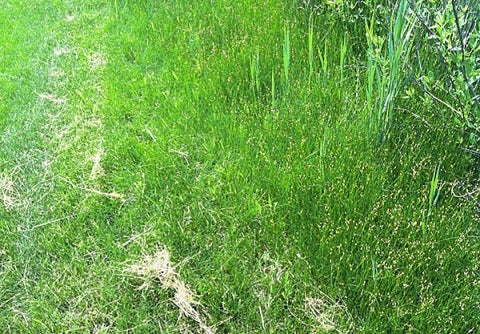Note: Yale School of the Environment (YSE) was formerly known as the Yale School of Forestry & Environmental Studies (F&ES). News articles and events posted prior to July 1, 2020 refer to the School's name at that time.
 <p class="p1"> The marsh border at Sherwood Island State Park, where the plant <i>Juncus gerardii</i> is currently being mowed, impeding migration.</p>
<p class="p1"> The marsh border at Sherwood Island State Park, where the plant <i>Juncus gerardii</i> is currently being mowed, impeding migration.</p>
A team of F&ES researchers has received a grant to investigate the ability of coastal salt marshes to migrate upland in the face of sea level rise and how the ecosystem types found at higher elevations will affect that potential migration.
During a two-year investigation, researchers will attempt to determine how quickly marsh systems along Long Island Sound can colonize newly wet areas as sea levels rise, how the process varies depending on characteristics of the upland areas, and what humans can do to encourage the migration.
The $130,000 grant was awarded by Connecticut Sea Grant, a state-federal partnership based at the University of Connecticut that supports research, education and outreach related to marine and aquatic issues.
While it is well known that sea level rise is drowning large areas of coastal salt marsh, converting once vibrant ecosystem into mudflats, very little research has been conducted on the possible expansion of marshland into newly wet areas, said Shimon Anisfeld, a senior lecturer and research scientist at F&ES who is leading the investigation.
“People haven’t looked as much at what happens on the upland edge of the marsh where it abuts a non-wetland,” Anisfeld said. “That’s important because if we’re losing marshes on the seaward end from sea-level rise, that also creates an opportunity for marshes on the upland edge.”
The researchers will look specifically at critical indicators of marsh expansion in upland areas, including the frequency of tidal flooding, soil conditions, vegetation, and the presence of microscopic organisms that only live in saltwater.
They will then try to determine whether the potential for migration varies in different types of landscapes, including forests, mowed lawns, and lawns where no mowing has occurred.
In addition to studying current conditions, the researchers will use aerial photos and sediment cores to determine how much the marshland borders have moved over the last century.
Their work will build on research led by Katharine Gehron M.E.Sc. ’14 at Sherwood Island State Park in Westport, Conn. last summer.
Andrew Kemp, a lab associate with Anisfeld, will be associate investigator for the new study.
During a two-year investigation, researchers will attempt to determine how quickly marsh systems along Long Island Sound can colonize newly wet areas as sea levels rise, how the process varies depending on characteristics of the upland areas, and what humans can do to encourage the migration.
The $130,000 grant was awarded by Connecticut Sea Grant, a state-federal partnership based at the University of Connecticut that supports research, education and outreach related to marine and aquatic issues.
While it is well known that sea level rise is drowning large areas of coastal salt marsh, converting once vibrant ecosystem into mudflats, very little research has been conducted on the possible expansion of marshland into newly wet areas, said Shimon Anisfeld, a senior lecturer and research scientist at F&ES who is leading the investigation.
“People haven’t looked as much at what happens on the upland edge of the marsh where it abuts a non-wetland,” Anisfeld said. “That’s important because if we’re losing marshes on the seaward end from sea-level rise, that also creates an opportunity for marshes on the upland edge.”
The researchers will look specifically at critical indicators of marsh expansion in upland areas, including the frequency of tidal flooding, soil conditions, vegetation, and the presence of microscopic organisms that only live in saltwater.
They will then try to determine whether the potential for migration varies in different types of landscapes, including forests, mowed lawns, and lawns where no mowing has occurred.
In addition to studying current conditions, the researchers will use aerial photos and sediment cores to determine how much the marshland borders have moved over the last century.
Their work will build on research led by Katharine Gehron M.E.Sc. ’14 at Sherwood Island State Park in Westport, Conn. last summer.
Andrew Kemp, a lab associate with Anisfeld, will be associate investigator for the new study.
– Kevin Dennehy kevin.dennehy@yale.edu 203 436-4842
Published
February 24, 2014